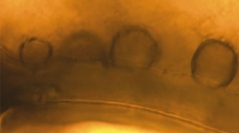

 Comptes Rendus Palevol
9 (1-2) - Pages 5-11
Comptes Rendus Palevol
9 (1-2) - Pages 5-11A new fossil water mold (Peronosporomycetes), Galtierella biscalithecae nov. gen. et sp., consisting of coenocytic hyphae occurs as an intracellular endophyte in a partially degraded specimen of the reproductive organ Biscalitheca cf. musata (Zygopteridales) from the Upper Pennsylvanian Grand-Croix cherts (Saint-Étienne Basin, France). Some hyphal tips produce small spheres that subsequently develop into ornamented, opaque-walled oogonia; amphigynous antheridia encircle the necks of several immature oogonia. Also present are ovoid structures, which may represent differently shaped oogonia, hyphal swellings, or zoosporangia. Small dome-shaped structures, probably zoospore cysts, are attached to numerous host cell walls. This discovery sheds new light on the morphology and biology of water molds in a Carboniferous ecosystem.
Biscalitheca cf. musata (Zygopteridales), Chert, Grand-Croix, Oogonium, Amphigynous antheridium, Saint-Étienne Basin, France